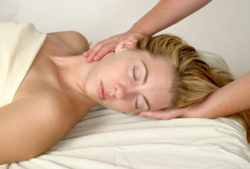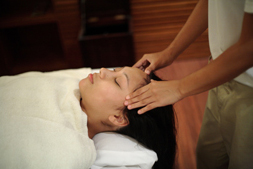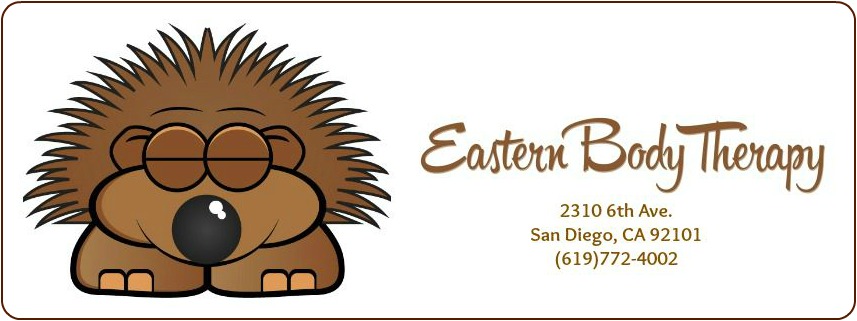Massage for the Brain | Dance of the Skull | What's Craniosacral Therapy Like | An Endless Web | Print This Page
Craniosacral therapy is a gentle bodywork technique which was developed out of the school of cranial osteopathy. Major pioneers in the field include John Upledger, Hugh Milne, and William Sutherland. The modality uses very gentle pressure anywhere on the body, but focusing on the skull and tailbone with the intent of encouraging the bones into their "normal" positions and ranges of motion. back to top

Contrary to what is believed by western anatomists, it has been demonstrated by osteopaths that the bones of the skull are not truly fused and that there is minute movement which must occur between these bones for normal brain and nervous system function.
Cerebrospinal fluid is produced deep within the brain, about one tablespoon at a time. This fluid is pumped out of the ventricles and into the space between the brain and the skull. Its purpose is to provide a mechanism for nutrient and waste exchange for the cells of the central nervous system. This fluid comes down from the brain, along the spinal cord, up the other side of the spinal cord, and eventually drains into the venous blood stream, becoming part of the fluid of the blood. The body produces cerebrospinal fluid at a rate of about 1 tablespoon per 5 seconds, or 12 cycles per minute. Each time this fluid is pumped out of the brain, the entire body expands slightly. As it empties out into the blood stream, the body contracts slightly. This rhythmic contraction and expansion of the body is called the craniosacral rhythm.(1)
When everything is functioning optimally, the rhythm is smooth and even over the whole body. There are no restrictions to movement of the skull, brain, or spinal cord in the spinal canal. When there are restrictions anywhere in the system, the entire body is affected in some way. Craniosacral therapy uses very slight pressures to release the restrictions in the bones and soft tissue of the skull, spine, and the rest of the body so that there is free flow and movement of cerebrospinal fluid and the craniosacral rhythm. back to top
Craniosacral therapy is generally performed with the patient fully clothed, though some practitioners incorporate it into other styles of massage and prefer to work with the patient undressed. The patient lies down on her back and is asked to relax as much as possible. The practitioner will place her hands on the patient with a very light touch. Different practitioners evaluate craniosacral rhythm from different areas, but most common are the feet, pelvic bones and skull.
It often feels like nothing is happening during a craniosacral session. The patient may feel a sense of warmth or heaviness both where the practitioner's hands are, and over the whole body. Most patients report a sense of profound relaxation and a hypnotic or dreamlike state within several minutes of starting a session. Some patients report a huge sensation of movement in their bodies as their restrictions are released.
As a practitioner, I sometimes feel as if a patient's body has expanded by several feet, only to look at my hands and see that if they have moved at all it is by a factor of millimeters.
Most of the time, there is a sense of well-being and calm during and for a period of time after the session. However, some patients find that as their bodies release old restrictions, there is a strong emotional change. There is another aspect of craniosacral therapy called Somatoemotional Release which uses therapeutic dialogue to facilitate release of emotions as well as the physical restrictions held in the craniosacral system. Patients may find themselves laughing, crying, screaming, and making big body movements as their bodies release accumulated tensions and restrictions. For most patients experiencing emotional release, the reaction is more subtle. For a week or so after the session they may feel a bit unsettled with a vague sense that something is strange. They may be more moody than usual, or feel unexplained urges to laugh or cry. This is a normal reaction to cranioscaral therapy, though any concerns you have should be discussed with your practitioner.
Much of the work to be done in craniosacral therapy is best done with the practitioner's hands in the patient's mouth. This is because many of the bones of the skull make up the roof of the mouth and the jaw. If this is what is appropriate, the practitioner will wear medical gloves while working in the patient's mouth. She will use light touch (about the weight of a nickel) on the bones of the mouth and/or on the muscles under the tongue. Most patients are surprised to find that this feels quite good, and is nowhere near as strange as it sounds! back to top

For any patient who has experienced a whiplash injury or has problems with his/her temporomandibular Joint, craniosacral therapy is a wonderful thing which MAY go a long way towards curing their pain.
As acupuncturists and massage therapists, we are not allowed to advertise that we can "cure" any disease or condition of the human body. Legally, only an MD can “cure” a disease. However, in practice, I have seen some patients have such a dramatic response to craniosacral therapy that pain which has been with them for years is completely gone. As with any treatment, there are no guarantees about how any individual will respond. Some patients see huge benefits, others have none. We will make every effort to make an appropriate referral if our treatment is not working for you.
Because it is such a subtle treatment, craniosacral therapy is safe for even the most acute injuries, and can have huge benefits on preventing soft tissue holding patterns from developing. I have used craniosacral therapy to relieve pain in patients with fibromyalgia and trigeminal neuralgia, as well as TMJ problems.
John Upledger, DO, has been doing research for several years on the use of craniosacral therapy with learning disabled and autistic children. His hypothesis is that the head banging behaviors of autistic children are an attempt to relieve pressure in the skull. He has found that use of craniosacral therapy has reduced this behavior and significantly improved the social skills of these children. He has also studied learning disabilities, and believes that many learning disabilities are due to undue pressure on specific areas of the brain due to restrictions in the movement of the craniosacral system. His research seems promising in terms of reducing the effects of learning disabilities with craniosacral therapy.
Because craniosacral therapy is working at the level of connective tissue rather than muscles, it can be used to effect any part of the body. Often, a patient's headaches will go away when his pelvis releases. Or, her back pain will be relieved when her frontal bone moves back into place. The entire body is connected via a web of connective tissue called fascia, and restrictions anywhere in the body can effect the entire body. This is how a patient can start having headaches after stubbing her toe! Craniosacral therapy can be used to release fascia restrictions anywhere in the body, and can thus have far reaching effects regardless of the body part. back to top
(1) Upledger, J. and Vredevoogd, J. Craniosacral Therapy. Eastland Press. Seattle, WA. 1983. p 14-15, 19.
|

 Yelp About Us
Yelp About Us 

